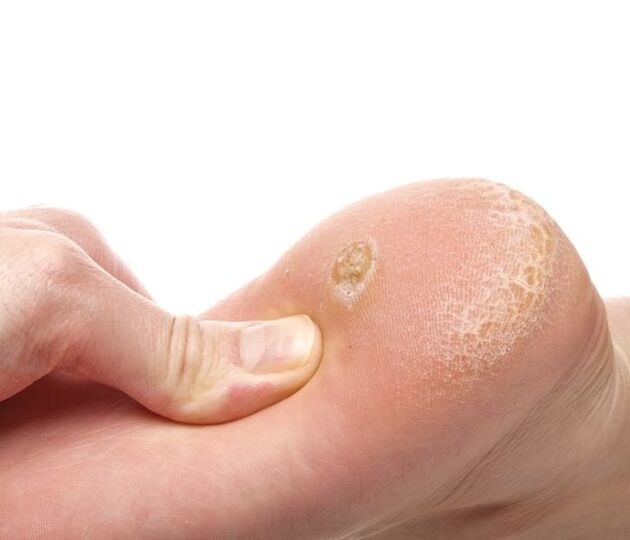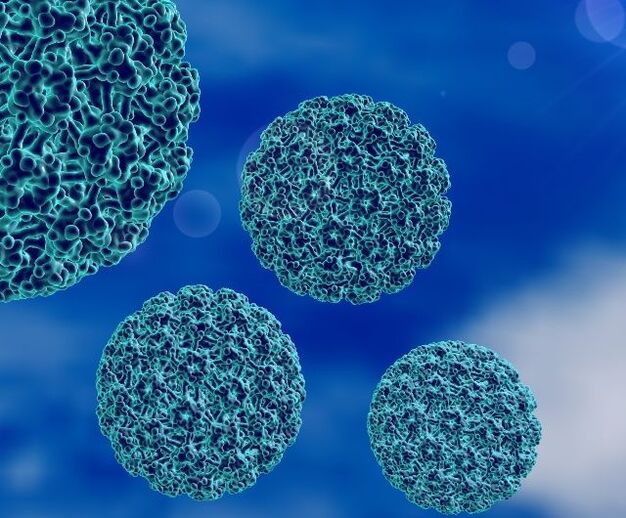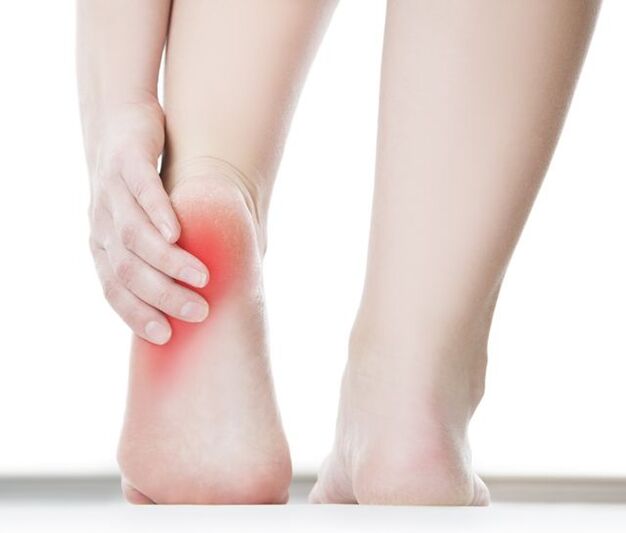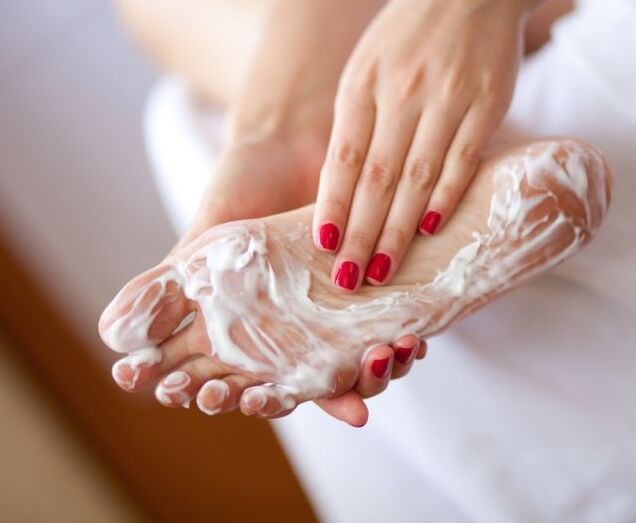
A heel wart is a growth that can cause great discomfort to the patient. The growth is formed under the influence of papillomavirus, and also mainly affects the damaged skin on the heels. It looks like an elastic and dense formation on the epidermis, covered with dry crusts.
Causes of warts on heels

Papillomavirus has the ability to infect different parts of the human body, causing proliferation of epithelial tissue. High heels are no exception. Here, as a rule, warts are formed, caused by HPV types 1, 2, 4, 27 and 57. In total, there are at least 100 strains of this pathogen in the world. It is very contagious and widespread, due to which about 80% of the world's population are carriers of this virus.
Of all the benign tumors that can be localized on the heel, warts account for one-third. It is quite easy to get infected with the HPV virus, which causes their appearance - the virus is transmitted from a sick person to a healthy person due to ordinary everyday contact in everyday life as well as in crowded places. Using other people's personal hygiene items, walking barefoot on the floor in crowded rooms (gyms, locker rooms, saunas, swimming pools) are all ways of transmitting papilloma virus.
Contrary to popular belief, it is almost impossible to be infected with HPV and "get" heel warts while at the beach. This pathogen quickly dies when dry and exposed to sunlight.
The formation of warts on the heels does not always occur immediately after infection with papillomavirus. People with strong immunity are usually not susceptible to the formation of warts and papillomas. The body's defense system blocks pathogens and does not cause harm to health. But as soon as the immune system weakens, which occurs due to overwork, hypothermia, infectious diseases, hormonal imbalance, poor nutrition, poisoning, HPV can become active and manifest itself in the form ofskin tumors.
In addition, there are several factors that accompany the appearance of warts on the heels:
- Injury to the cuticle on the heel - cracks, abrasions, abrasions, cuts;
- Using ill-fitting shoes that pinch, compress or rub the skin;
- Diseases that cause trophic changes in soft tissue - varicose veins, diabetes, atherosclerosis;
- Deforming pathologies of the lower extremities - flat feet, arthritis, osteoarthritis and others;
- Excessive sweating or excessive dryness and sensitivity of the cuticles of the feet.
As a rule, if the virus is not too active and the immune system fights, heel warts can appear in single form. If the pathogen is active, the heels and feet can be seriously damaged by warts.
Methods of diagnosing heel warts

Due to constant pressure on the feet and heels, warts in this area often become very similar to corns and calluses. So they are not easy to identify. An excellent dermatologist can make an accurate diagnosis and differentiate the growth from other pathologies. To do this, a procedure called dermoscopy is most often performed.
To conduct a qualitative study, the stratum corneum of the epidermis was scraped and sampled. The scraping results are sent to the laboratory. There they confirm or deny the presence of HPV.
Visual examination can also help give a clear picture of the disease. With heel warts, its surface has no skin marks. Additionally, you may see blackheads. These are traces of clogged capillaries.
If required, an ultrasound examination will be prescribed, which will help determine the depth of penetration of the so-called "roots" of the wart deep into the skin.
It is necessary to differentially diagnose a tumor on the heel in the following cases:
- Presence of cancerous lesions in the patient;
- Foot deformities due to many different causes;
- Reiter's syndrome, which can provoke the development of keratoderma;
- Syphilis, which can cause painful ring-shaped tumors to form in the feet and hands.
To clarify the diagnosis, blood tests for HPV, syphilis and general analysis are also performed.
Why is it important to treat heel warts?

Although heel warts are considered a fairly harmless pathology, consultation with a doctor and treatment should not be delayed. Over time, the disease can become more severe. In addition, self-medication at home can only prevent external manifestations of papillomavirus infection. At the same time, the virus will exist for a long time in the blood and cause warts to recur frequently on the body.
It is also important to remember that heel warts continue to grow and they continue to grow. Furthermore, due to external pressure on the foot, the tumor grows inside the skin, affecting the soft tissues deeper and deeper. This causes compaction of the epidermal layers and the formation of blood clots in the capillaries, which manifest as black dots on the growth surface. Gradually, heel warts begin to cause severe pain.
Treatment of heel warts is necessary when the following symptoms are present:
- Severe pain in the growth area;
- Warts grow rapidly and cause damage to new areas on the heel;
- Discomfort when walking and supporting the legs.
It should also be remembered that a patient infected with a virus poses a threat to others because he is a carrier of the virus. Relatives of such a person are at risk of infection at home.
Only comprehensive treatment can help completely eliminate pathological tumors and suppress the virus, as well as avoid recurrence.
Ways to treat heel warts
Only combination therapy can help people who do not know how to remove heel warts. This is an opportunity not only to eliminate the tumor and the discomfort associated with it, but also to lead a fulfilling life without posing a threat to others. Warts are treated with special drugs, instrumental removal methods, and sometimes you can resort to traditional medicine.
Medicine to treat warts on heels
There are many medications available to treat heel warts. They are divided into different groups depending on their composition and characteristics of their impact on tumors and pathogenic viruses.
Let's look at the main fund groups:
- Acidic substance. These medications are available in pharmacies without a prescription and are usually inexpensive. They have a pronounced burning effect. Salicylic acid gives good results. To remove warts on the heels, a solution of 10-60% concentration is required. The product should be applied once a day until the tumor is completely destroyed. This substance is not suitable for patients with diabetes and cancer. An analogue of salicylic acid is trichloroacetic acid.
- The product is alkaline. These substances have almost the same effect on pathological tissues as the previous substances. They also burn warts and cause diseased areas in the dermis to die. The most common drug in this group causes tissue necrosis, so it must be used as directed and with caution towards adjacent healthy tissue.
- Frozen medicine. Until recently, heel warts were only frozen in the hospital using liquid nitrogen. Now this procedure can be performed at home using special pharmaceutical preparations. A mixture of dimethyl alcohol and propane has been shown to work well. The refrigerant is liquid nitrogen. The product helps remove warts on heels and kills papilloma virus. The use of this drug also requires special care so as not to cause damage to healthy tissues.
- Antiviral creams, gels, ointments. These remedies are effective because they act directly on the cause of warts - HPV. Although usually a longer exposure to the tumor is required than in the case of using strong burning agents. One of the most effective drugs in this group is an ointment based on an extract from potato shoots. It has herbal ingredients and helps stimulate interferon production in the body, which interrupts the recovery process of viruses and causes them to die quickly.
- External agents regulate immunity. They are quite effective in treating single small warts on the heels. They help stimulate the local immune response and the body independently suppresses the virus. Interferon-based ointments are popular. Long-term application is required - for at least 4 weeks until a noticeable therapeutic effect appears.
- Antiviral and immunomodulating drugs in pill form. If HPV levels in the blood are high, the doctor may prescribe a course of immunomodulatory or antiviral therapy using oral tablets. This will prevent pathogens from inside, avoiding the risk of recurrence. This is especially important in immunocompromised states.
If local burning agents can be used independently to treat heel warts, according to the instructions, then oral medications should be prescribed only by the attending physician based on these tests.
Specific methods for removing heel warts

Today there are several effective ways to remove heel warts using various devices. Modern clinics can offer a number of highly effective instrumental techniques at different costs:
- Burn electricity. Heel warts that develop over time often have roots deep into the dermis. Electrocautery does not involve deep penetration into soft tissue. Therefore, this method is only used to treat small, superficial tumors. In addition, electrocautery often leaves scars.
- Cold destruction. One of the most common methods for removing heel warts is using liquid nitrogen. Additionally, this is a fairly cheap method of influence. Scars rarely remain after manipulation. But the effectiveness of the method depends on the skill of the doctor, because it is necessary to accurately determine the depth of root development before removing the wart on the heel. Otherwise, the tumor may recur. The procedure is quick, as is the tissue regeneration time.
- Laser removal. One of the most modern, minimally invasive methods for treating developmental skin diseases. Allows you to achieve good aesthetic effects. The penetration depth of the laser beam can be adjusted easily, unlike liquid nitrogen. The procedure is short and virtually painless. The heel wound also healed quickly and without complications. Recurrence after laser treatment of heel warts is almost excluded.
- Eliminate radio waves. In this case, the wart is removed with a special radio knife. At the same time, blood vessels are cauterized to avoid the spread of the virus to healthy tissues and causing bleeding. After such surgery there is also a short recovery period and almost no scarring.
- Surgical excision. This method is considered outdated but is still used in some cases. For example, when the tumor grows very large and a deeper histological examination of the removed tissue is required. The surgery is quite painful, is performed under local anesthesia, and recovery can last several weeks. Bleeding and inflammation may also occur. Scars often form. The relative advantage of this method of treating heel warts is its low cost.
The choice of how to treat heel warts depends on the patient and the treating doctor. Usually, the gentlest and least invasive techniques are chosen - removal of tumors using laser and radio waves.
Folk remedies to treat warts on heels
If you have heel warts and don't know what to do, you can try treating them with some substances at home. So, acetic acid, celandine juice, garlic juice, etc. v. favored by "traditional physicians". These remedies are less effective than pharmaceutical drugs or instrumental methods. However, with regular application, they can also have positive effects. The main condition is not to interrupt treatment until the tumor completely disappears.
In addition, the immunomodulatory effect on the body can provide real help in treating heel warts with folk methods. To do this, take a decoction of the following plants: rose hip, horseradish, sea buckthorn, mint, chamomile, lemon balm, black currant and raspberry leaves, calendula. These plants will help strengthen immunity, especially in cold weather, when there is not enough fresh fruits and vegetables. It is also useful to consume freshly squeezed juices and various fruit drinks and juices.
Preventing heel warts

Preventing human papillomavirus infection is the most effective way to fight it. So, follow the rules of personal hygiene, try not to use other people's things and always wear replaceable shoes in public places.
If you have been infected with HPV and have heel warts, start treating them immediately. After removing the growth, carefully monitor the condition of the foot.
If you suffer from hyperhidrosis, you should only use shoes made from natural, comfortable and breathable materials. If your feet are deformed, wear orthopedic shoes to eliminate excess stress on your feet.
Don't forget to clean your toenails and use moisturizer if your heel skin is dry. Avoid developing cracked heels. Simple rules of prevention can prevent the recurrence of the tumor.
Heel warts are potentially harmless growths, but they can bring significant discomfort to the patient, because as they grow, they put pressure on the tissue and cause pain. In addition, we should not forget that this is the formation of a virus and therefore humans are the source of infection. Therefore, treatment of heel warts must be done under the supervision of a doctor.














































































